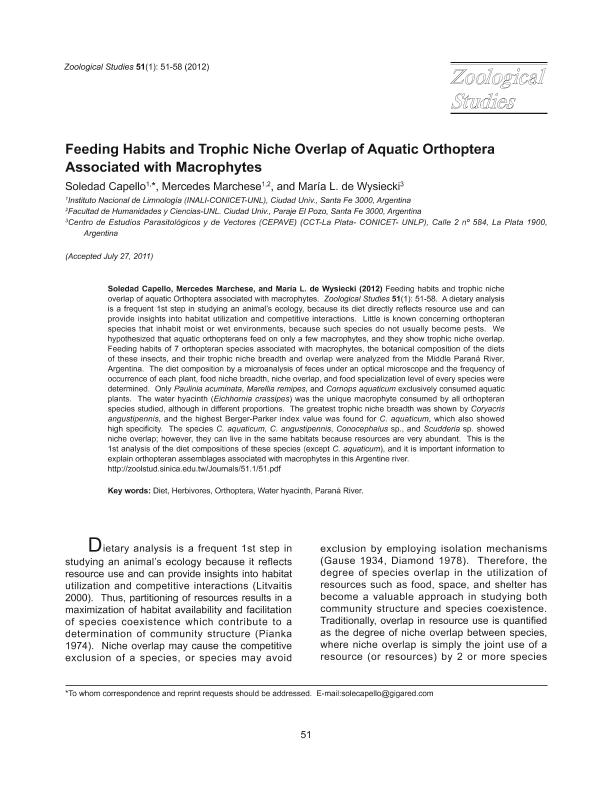Mostrar el registro sencillo del ítem
dc.contributor.author
Capello, Soledad

dc.contributor.author
Marchese, Mercedes
dc.contributor.author
de Wysiecki, Maria Laura

dc.date.available
2020-03-25T21:48:59Z
dc.date.issued
2012-01
dc.identifier.citation
Capello, Soledad; Marchese, Mercedes; de Wysiecki, Maria Laura; Feeding habits and trophic niche overlap of the aquatic Orthoptera associated to macrophytes; Academia Sinica; Zoological Studies; 51; 1-2012; 51-58
dc.identifier.issn
1021-5506
dc.identifier.uri
http://hdl.handle.net/11336/100841
dc.description.abstract
The dietary analysis is a frequent first step in studying an animal?s ecology because diet directly reflects resource use and can provide insight into habitat utilization and competitive interactions. Little is known concerning the Orthoptera species that inhabit moist or wet environments because usually such species do not become pests. We hypothesized that the aquatic orthopterans are feeding only on few macrophytes and they show trophic niche overlap. The feeding habits of seven species of Orthoptera associated to macrophytes, the botanical composition of diet of these insects and their trophic niche breadth and overlapping were analyzed. The diet composition by microanalysis of feces under an optical microscope and frequency of occurrence of each plant, food niche breadth, niche overlap and the food specialization level of every species were determined. Only Paulinia acuminata, Marellia remipes and Cornops aquaticum consumed aquatic plants exclusively. The water hyacinth (Eichhornia crassipes) was the unique macrophyte consumed by all the species of Orthoptera, although in different proportions. The highest trophic niche breadth was shown by Coryacris angustipennis and the highest Berger-Parker index value was reached by C. aquaticum, showing a high specificity. The species C. aquaticum, C. angustipennis, Conocephalus sp. and Scudderia sp. show a niche overlapping; however they may live in the same habitats because the resources are very abundant. The diet composition of these species (except C. aquaticum) is the first time that was analyzed and it is important information to explain the Orthoptera assemblages associated to macrophytes of the Middle Paraná River.
dc.format
application/pdf
dc.language.iso
eng
dc.publisher
Academia Sinica

dc.rights
info:eu-repo/semantics/openAccess
dc.rights.uri
https://creativecommons.org/licenses/by-nc-sa/2.5/ar/
dc.subject
DIET
dc.subject
HERBIVORES
dc.subject
ORTHOPTERA
dc.subject
WATER HYACINTH
dc.subject
PARANÁ RIVER
dc.subject.classification
Ecología

dc.subject.classification
Ciencias Biológicas

dc.subject.classification
CIENCIAS NATURALES Y EXACTAS

dc.title
Feeding habits and trophic niche overlap of the aquatic Orthoptera associated to macrophytes
dc.type
info:eu-repo/semantics/article
dc.type
info:ar-repo/semantics/artículo
dc.type
info:eu-repo/semantics/publishedVersion
dc.date.updated
2020-03-25T13:49:14Z
dc.journal.volume
51
dc.journal.pagination
51-58
dc.journal.pais
China

dc.description.fil
Fil: Capello, Soledad. Consejo Nacional de Investigaciones Científicas y Técnicas. Centro Científico Tecnológico Conicet - Santa Fe. Instituto Nacional de Limnología. Universidad Nacional del Litoral. Instituto Nacional de Limnología; Argentina
dc.description.fil
Fil: Marchese, Mercedes. Consejo Nacional de Investigaciones Científicas y Técnicas. Centro Científico Tecnológico Conicet - Santa Fe. Instituto Nacional de Limnología. Universidad Nacional del Litoral. Instituto Nacional de Limnología; Argentina
dc.description.fil
Fil: de Wysiecki, Maria Laura. Consejo Nacional de Investigaciones Científicas y Técnicas. Centro Científico Tecnológico Conicet - La Plata. Centro de Estudios Parasitológicos y de Vectores. Universidad Nacional de La Plata. Facultad de Ciencias Naturales y Museo. Centro de Estudios Parasitológicos y de Vectores; Argentina
dc.journal.title
Zoological Studies

dc.relation.alternativeid
info:eu-repo/semantics/altIdentifier/url/http://zoolstud.sinica.edu.tw/Journals/51.1/51.pdf
Archivos asociados
